Whether you want to splash in the turquoise waters of Inkwell Beach or would rather dive headfirst into the island’s history on the African American Heritage Trail, Martha’s Vineyard has great options for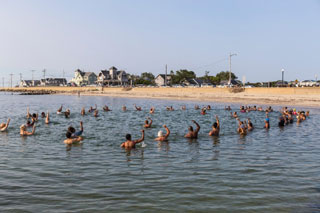 you to enjoy long after Black History Month has ended!
you to enjoy long after Black History Month has ended!
Spurred by late 18th century Methodist and Baptist revivals, Martha’s Vineyard transitioned from its industrial days of whaling, brick-making, and farming to its current iteration as a summer resort community. While much of the island was not welcoming to vacationers of color until quite recently, since the late 1890’s the town of Oak Bluffs gained notoriety as a refuge for African-Americans looking to enjoy the beach.
The religious revival movement brought some African Americans to Martha’s Vineyard. Still more came to work in the homes of summer visitors. From there many of these black visitors to Martha’s Vineyard became year-rounders. Some bought property and began operating inns. According to BlackPast.org “In the 1920’s the African American Islanders began to offer accommodations in their small cottages that attracted black visitors from Boston, New York, Philadelphia, and other Northeast cities.”
Inkwell Beach
 The beach they came to enjoy was known as the Inkwell, either as a pejorative name coined by white residents describing the skin color of the beachgoers or as a nod to the ink in the pens of the writers and thinkers who frequented the rocky sands, including black writers of the Harlem Renaissance.
The beach they came to enjoy was known as the Inkwell, either as a pejorative name coined by white residents describing the skin color of the beachgoers or as a nod to the ink in the pens of the writers and thinkers who frequented the rocky sands, including black writers of the Harlem Renaissance.
Inkwell Beach’s gentle bay-side waves are perfect for kids, and the Inkwell is still a favorite of residents and visitors alike to this day! A polar-bear club meets first thing in the morning to swim, and the beach is a happening place through the days and often into the evenings, with friends visiting, splashing, and enjoying summer days on the Vineyard.
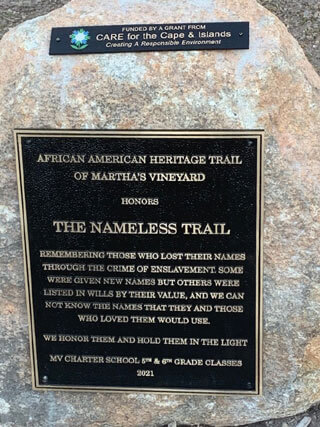 African American Heritage Trail
African American Heritage Trail
For those looking to explore the Vineyard’s black history and notable residents, consider following the informative plaques of the African American Heritage Trail that leads visitors across the island with over 30 stops exploring the island’s history. The stops explore a range of stories and sites relevant to the black experience on the island throughout its history. These range from stories of people enslaved on the island like Rebecca Amos, “Born in Africa, and enslaved in Chilmark.” as well as the way fugitives from slavery, hunted by the Fugitive Slave Act of 1851, who escaped the island via Menemsha, with the help of members of the Wampanoag tribe in Aquinnah.
Other stops explore the fascinating life of Nancy Michael, a woman who was enslaved and came to be feared and respected by superstitious sailors who sought her favor prior to departing on long whaling voyages. A few stops also note the life of her grandson, William A. Martin, the only African American Master of Whaling Ships on Martha’s Vineyard, just a generation removed from enslavement.
Other spots explore the entrepreneurship of the Vineyard’s black residents, including the Shearers. Many of the black visitors who spent time in Oak Bluffs in the early years of the island’s vacation days enjoyed the town so much that they bought the property and started small businesses.
In 1912 Charles and Henrietta Shearer opened an inn, the first African American-owned guesthouse on the island, and catered to the black Americans looking to vacation on the island in an era of segregation. The Inn attracted a variety of well-known black artists of the day, who enjoyed the ability to be their authentic selves in Oak Bluffs. The Martha’s Vineyard Times reports that “Whether just for the summer or year-round, Oak Bluffs has been what Maya Angelou describes as home, “a safe place where we can go as we are and not be questioned.” The Shearer Cottage is still run by descendants of the Shearers, though it is currently closed for renovations.
Stops in Oak Bluffs include the Bradley Memorial Church, the Eastville Cemetery, Shearer Cottage, the Gospel Tabernacle, Powell Cottage (once owned by Adam Clayton Powell, the first African American congressman from the east coast since Reconstruction, and a leader in the passage of civil rights legislation in the 1960s and ’70s), the home of Dorothy West, the Landladies of Oak Bluffs, and Villa Rosa: The Overton House.
For more information on the trail’s stops, tours, and more, visit the African American Heritage Trail of Martha’s Vineyard’s website.





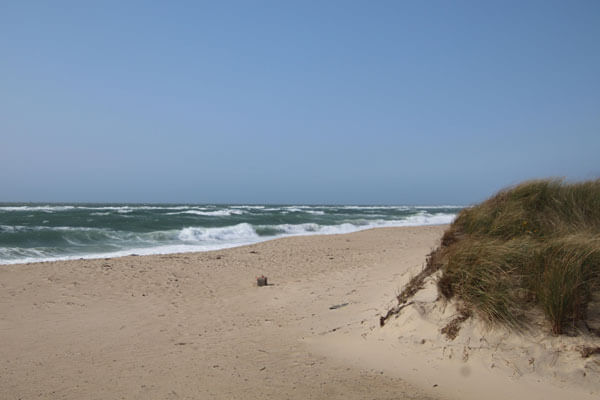
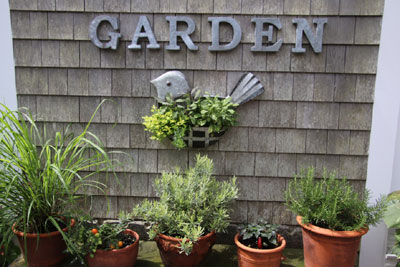
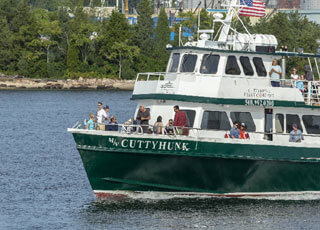

This Post Has 4 Comments
Pingback: Margaret Moseley: Black History On Cape Cod
Pingback: Museum Of African American History & Culture
Pingback: 10 Best Beaches For Kids On Martha's Vineyard
Pingback: The Zion Union Heritage Museum: Embracing Legacy | Cape Cod Xplore